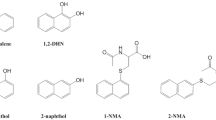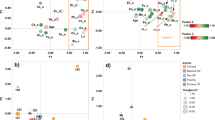Abstract
This study was performed to assess the relation between occupational exposure to N,N-dimethylformamide after an 8 h work shift in the acrylic fibre industry and its three biological markers N-methylformamide (NMFtotal), N-acetyl-S-(N-methylcarbamoyl)cysteine (AMCC), and N-methylcarbamoyl adduct at haemoglobin (MCVal). External DMF exposure of 220 workers was determined during the whole shift. A standardised questionnaire was used to obtain information about the worker’s general health status, medical treatment, smoking habits, protective measures, and possible symptoms caused by DMF exposure. NMF and AMCC were analysed in post-shift urine samples and MCVal in blood. For longitudinal assessment the average AMCC concentration was determined over a period of 4 weeks (weekly sampling) in a sub-collective of 89 workers. The median of DMF concentration in air was 3.19 mg/m3 (range < 0.15–46.9 mg/m3). The biological markers showed a median of 4.80 mg/L (range 0.20–50.6 mg/L) for NMFtotal, 4.75 mg/g creatinine (range 0.06–49.6 mg/g creatinine) for AMCC, and 57.5 nmol/g globin (range 0.5–414 nmol/g) for MCVal. A significant linear relationship was observed between DMF in air and NMF as well as between DMF in air and AMCC in post-shift urine samples. The mean AMCC values measured weekly over a period of 4 weeks correlated significantly with MCVal adducts too. Excluding workers who had been using breathing masks on the day of the study led to even tighter correlations. The results of the present study demonstrate the applicability of the DMF biomonitoring parameters NMFtotal in post-shift urine for the present-day exposure assessment, AMCC in the post-shift urine after several shifts for assessment of the cumulative exposure of the previous working days, and MCVal for assessment of long-term exposure during previous weeks and months. The data of the present study enable now the estimation of valid equivalents of these biomonitoring parameters to the external DMF exposure. From the risk assessment point of view, the exposure limit values for AMCC and MCVal, which are directly linked to the presumed toxic intermediate MIC, exhibit a significant advance.




Similar content being viewed by others
References
ACGIH - American Conference of Governmental Industrial Hygienists (2017) 2017 TLV and BEI list. ACGIH, Cincinnati
Angerer J, Göen T, Krämer A, Käfferlein HU (1998) N-Methylcarbamoyl adducts at the N-terminal valine of globin in workers exposed to N,N-dimethylformamide. Arch Toxicol 72(5):309–313. https://doi.org/10.1007/s002040050507
Brugnone F, Perbellini L, Gaffuri E (1980) N-N-Dimethylformamide concentration in environmental and alveolar air in an artificial leather factory. Br J Ind Med 37(2):185–188
Casal Lareo A, Perbellini L (1995) Biological monitoring of workers exposed to N,N-dimethylformamide. II. Dimethylforamide and its metabolites in urine of exposed workers. Int Arch Occup Environ Health 67(1):47–52
DFG - Deutsche Forschungsgemeinschaft (2017) List of MAK and BAT values 2017. Permanent Senate Commission for the Investigation of Health Hazards of Chemical Compounds in the Work Area, Report 53. Wiley-VCH, Weinheim. https://doi.org/10.1002/9783527812127
Drexler H, Göen T, Angerer J (1995) Carbon disulphide. II. Investigations on the uptake of CS2 and the excretion of its metabolite 2-thiothiazolidine-4-carboxylic acid after occupational exposure. Int Arch Occup Environ Health 67(1):5–10. https://doi.org/10.1007/BF00383126
Fennell TR, Sumner SC, Walker VE (1992) A model for the formation and removal of hemoglobin adducts. Cancer Epidemiol Biomark Prev 1(3):213–219
Fleming LE, Shalat SL, Redlich CA (1990) Liver injury in workers exposed to dimethylformamide. Scand J Work Environ Health 16(4):289–292
Garte S, Gaspari L, Alexandrie AK et al (2001) Metabolic gene polymorphism frequencies in control populations. Cancer Epidemiol Biomark Prev 10(12):1239–1248
Gescher A (1993) Metabolism of N,N-dimethylformamide: key to the understanding of its toxicity. Chem Res Toxicol 6(3):245–251
Göen T, Schaller KH, Drexler H (2012) External quality assessment of human biomonitoring in the range of environmental exposure levels. Int J Hyg Environ Health 215:229–232. https://doi.org/10.1016/j.ijheh.2011.08.012
Hyland R, Gescher A, Thummel K, Schiller C, Jheeta P, Mynett K, Smith AW, Mráz J (1992) Metabolic oxidation and toxication of N-methylformamide catalyzed by the cytochrome P450 isoenzyme CYP2E1. Mol Pharmacol 41:259–266
IARC - International Agency for Research on Cancer (1999) Re-evaluation of some organic chemicals, hydrazine and hydrogen peroxide. IARC Monographs on the evaluation of carcinogenic risks to humans, vol 71. World Health Organization, Genveva
Imbriani M, Maestri L, Marraccini P, Saretto G, Alessio A, Negri S, Ghittori S (2002) Urinary determination of N-acetyl-S-(N-methylcarbamoyl)cysteine and N-methylformamide in workers exposed to N,N-dimethylformamide. Int Arch Occup Environ Health 75(7):445–452. https://doi.org/10.1007/s00420-002-0335-3
Käfferlein HU, Angerer J (2001) N-Methylcarbamoylated valine of hemoglobin in humans after exposure to N,N-dimethylformamide: evidence for the formation of methyl isocyanate? Chem Res Toxicol 14(7):833–840
Käfferlein HU, Göen T, Müller J, Wrbitzky R, Angerer J (2000) Biological monitoring of workers exposed to N,N-dimethylformamide in the synthetic fibre industry. Int Arch Occup Environ Health 73(2):113–120
Käfferlein HU, Ferstl C, Burkhart-Reichl A, Hennebrüder K, Drexler H, Brüning T, Angerer J (2005) The use of biomarkers of exposure of N,N-dimethylformamide in health risk assessment and occupational hygiene in the polyacrylic fibre industry. Occup Environ Med 62(5):330–336. https://doi.org/10.1136/oem.2004.017129
Käfferlein HU, Angerer J, Leng G, Gries W, Göen T, Eckert E, Ferstl C, Hartwig A, MAK Commission (2016) 3-Methyl-5-isopropylhydantoin as hemoglobin adduct of N,N-dimethylformamide and methylisocyanate. MAK Collect Occup Health Saf 1(1):554–577. https://doi.org/10.1002/3527600418.bi6812e2115a
Kawai T, Yasugi T, Mizunuma K, Watanabe T, Cai SX, Huang MY, Ikeda M (1992) Occupational dimethylformamide exposure. 2. Monomethylformamide excretion in urine after occupational dimethylformamide exposure. Int Arch Occup Environ Health 63(7):455–460
Kennedy GL (1986) Biological effects of acetamide, formamide, and their monomethyl and dimethyl derivatives. Crit Rev Toxicol 17(2):129–182. https://doi.org/10.3109/10408448609023768
Kestell P, Gill MH, Threadgill MD, Gescher A, Howarth OW, Curzon EH (1986) Identification by proton NMR of N-(hydroxymethyl)-N-methylformamide as the major urinary metabolite of N,N-dimethylformamide in mice. Life Sci 38(8):719–724
Kestell P, Threadgill MD, Gescher A, Gledhill AP, Shaw AJ, Farmer PB (1987) An investigation of the relationship between the hepatotoxicity and the metabolism of N-alkylformamides. J Pharmacol Exp Ther 240(1):265–270
Kilo S, Göen T, Drexler H (2016) Cross-sectional study on N,N-dimethylformamide (DMF); effects on liver and alcohol intolerance. Int Arch Occup Environ Health 89:1309-1320. https://doi.org/10.1007/s00420-016-1164-0
Kim HA, Kim K, Heo Y, Lee SH, Choi HC (2004) Biological monitoring of workers exposed to N,N-dimethylformamide in synthetic leather manufacturing factories in Korea. Int Arch Occup Environ Health 77(2):108–112. https://doi.org/10.1007/s00420-003-0474-1
Kimmerle G, Eben A (1975a) Metabolism studies of N,N-dimethylformamide. I. Studies in rats and dogs. Int Arch Arbeitsmed 34(2):109–126
Kimmerle G, Eben A (1975b) Metabolism studies of N,N-dimethylformamide. II. Studies in persons. Int Arch Arbeitsmed 34(2):127–136
Mráz J, Nohová H (1992a) Absorption, metabolism and elimination of N,N-dimethylformamide in humans. Int Arch Occup Environ Health 64(2):85–92
Mráz J, Nohová H (1992b) Percutaneous absorption of N,N-dimethylformamide in humans. Int Arch Occup Environ Health 64(2):79–83
Mráz J, Tureek F (1987) Identification of N-acetyl-S-(N-methylcarbamoyl)cysteine, a human metabolite of N,N-dimethylformamide and N-methylformamide. J Chromatogr B 414(2):399–404
Mráz J, Cross H, Gescher A, Threadgill MD, Flek J (1989) Differences between rodents and humans in the metabolic toxification of N,N-dimethylformamide. Toxicol Appl Pharmacol 98(3):507–516
Mráz J, Jheeta P, Gescher A, Hyland R, Thummel K, Threadgill MD (1993) Investigation of the mechanistic basis of N,N-dimethylformamide toxicity. Metabolism of N,N-dimethylformamide and its deuterated isotopomers by cytochrome P450 2E1. Chem Res Toxicol 6(2):197–207
Mráz J, Dušková S, Gálová E, Nohová H, Krausová P, Linhart I, Šimek P (2002a) Improved gas chromatographic-mass spectrometric determination of the N-methylcarbamoyl adduct at the N-terminal valine of globin, a metabolic product of the solvent N,N-dimethylformamide. J Chromatogr B 778(1–2):357–365
Mráz J, Dušková S, Gálová E, Nohová H, Brabec M (2002b) Biological monitoring of N,N-dimethylformamide. Reference value for N-methylcarbamoyl adduct at the N-terminal valine of globin as a biomarker of chronic occupational exposure. Int Arch Occup Environ Health 75 Suppl:S93-S96. https://doi.org/10.1007/s00420-002-0387-4
Mráz J, Šimek P, Chvalová D, Nohová H, Šmigolová P (2004) Studies on the methyl isocyanate adducts with globin. Chem Biol Interact 148(1):1–10. https://doi.org/10.1016/j.cbi.2003.06.003
Mráz J, Cimlová J, Stránský V, Nohová H, Kičová R, Šimek P (2006) N-Methylcarbamoyl-lysine adduct in globin: a new metabolic product and potential biomarker of N,N-dimethylformamide in humans. Toxicol Lett 162:211–219. https://doi.org/10.1016/j.toxlet.2005.09.039
Nomiyama T, Nakashima H, Chen LL, Tanaka S, Miyauchi H, Yamauchi T, Omae K (2001) N,N-Dimethylformamide: significance of dermal absorption and adjustment method for urinary N-methylformamide concentration as a biological exposure item. Int Arch Occup Environ Health 74(3):224–228
O’Malley M, Barry T, Verder-Carlos M, Rubin A (2004) Modeling of methyl isothiocyanate air concentrations associdated with community illness following Metam-Sodium sprinkler application. Am J Ind Med 46(1):1–15. https://doi.org/10.1002/ajim.20037
Osunsanya T, Adejoro B, King B (2001) Biological monitoring of workers exposed to dimethylformamide in a textile polyurethane unit. Occup Med (Lond) 51(6):374–379
Pearson PG, Slatter JG, Rashed MS, Han DH, Grillo MP, Baillie TA (1990) S-(N-Methylcarbamoyl) glutathione: a reactive S-linked metabolite of methylisocyanate. Biochem Biophys Res Commun 166(1):245–250
Redlich CA, Beckett WS, Sparer J, Barwick KW, Riely CA, Miller H, Cullen MR (1988) Liver disease associated with occupational exposure to the solvent dimethylformamide. Ann Intern Med 108(5):680–686
Sakai T, Kageyama H, Araki T, Yosida T, Kuribayashi T, Masuyama Y (1995) Biological monitoring of workers exposed to N,N-dimethylformamide by determination of the urinary metabolites, N-methylformamide and N-acetyl-S-(N-methylcarbamoyl) cysteine. Int Arch Occup Environ Health 67(2):125–129
Scailteur V, Lauwerys R (1984) In vivo metabolism of dimethylformamide and relationship to toxicity in the male rat. Arch Toxicol 56(2):87–91
Scailteur V, de Hoffmann E, Buchet JP, Lauwerys R (1984) Study on in vivo and in vitro metabolism of dimethylformamide in male and female rats. Toxicology 29(3):221–234
Threadgill MD, Axworthy DB, Baillie TA, Farmer PB, Farrow KC, Gescher A, Shaw AJ (1987) Metabolism of N-methylformamide in mice: primary kinetic deuterium isotope effect and identification of S-(N-methylcarbamoyl)glutathione as a metabolite. J Pharmacol Exp Ther 242(1):312–319
Wang JD, Lai MY, Chen JS, Lin JM, Chiang JR, Shiau SJ, Chang WS (1991) Dimethylformamide-induced liver damage among synthetic leather workers. Arch Environ Health 46(3):161–166. https://doi.org/10.1080/00039896.1991.9937444
Will W, Bader M, Göen T, Hartwig A, MAK Commission (2016) N,N-Dimethylformamide and N,N-dimethylacetamide—determination of N-methylformamide and N-methylacetamide in urine. MAK Collect Occup Health Saf 1:536–553. https://doi.org/10.1002/3527600418.bi6812e2115b
Wrbitzky R, Angerer J (1998) N,N-Dimethylformamide—influence of working conditions and skin penetration on the internal exposure of workers in synthetic textile production. Int Arch Occup Environ Health 71:309–316
Acknowledgements
The study was carried out with financial support from the Industrievereinigung Chemiefaser (IVC, Frankfurt) and the Franz Koelsch Foundation (Erlangen). The authors would like to thank all participants who took part in the study and the management of the plants for their support. The authors acknowledge Sabine Straube, Werner Winter, Silvia Schels, Thomas Kokoschka, Birgit Hofmann, and Olga Battermann for their assistance in planning and carrying out the study. The present work was performed in (partial) fulfilment of the requirements for obtaining the degree “Dr. med.” to Mirjam Seitz.
Author information
Authors and Affiliations
Corresponding author
Ethics declarations
Conflict of interest
The authors declare no conflict of interest.
Electronic supplementary material
Below is the link to the electronic supplementary material.
Rights and permissions
About this article
Cite this article
Seitz, M., Kilo, S., Eckert, E. et al. Validity of different biomonitoring parameters for the assessment of occupational exposure to N,N-dimethylformamide (DMF). Arch Toxicol 92, 2183–2193 (2018). https://doi.org/10.1007/s00204-018-2219-7
Received:
Accepted:
Published:
Issue Date:
DOI: https://doi.org/10.1007/s00204-018-2219-7




